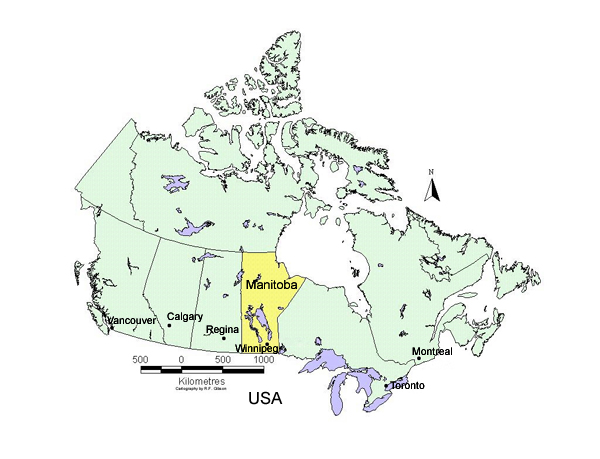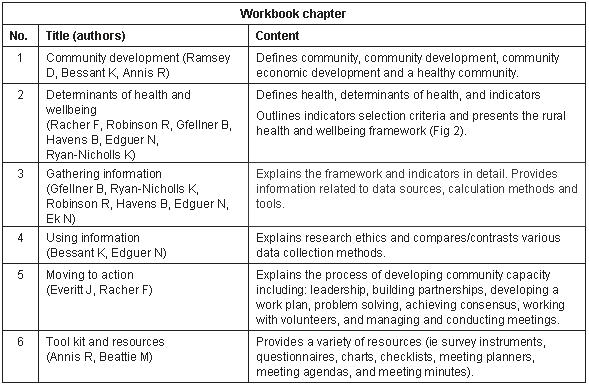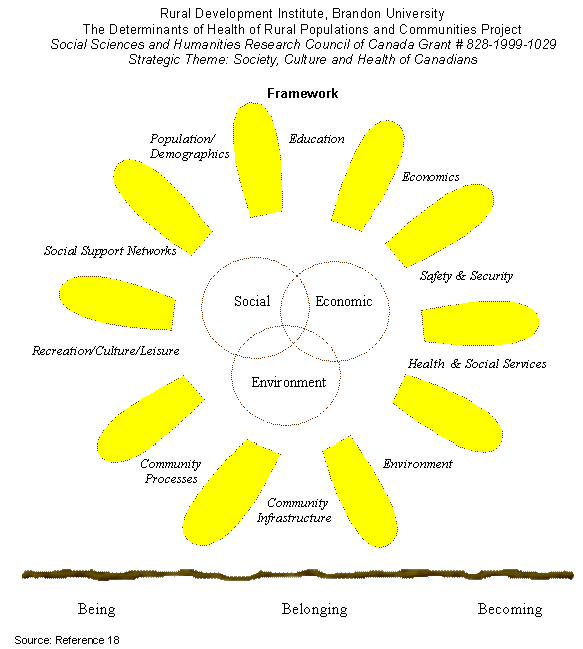Research to describe and measure the health of rural Canadians has received limited priority. Rural residents, rural community leaders, rural planners, rural health authorities and community organizations have attempted to understand the health, quality of life and sustainability of their communities (KD Ryan-Nicholls, FE Racher, B Gfellner, R Annis. Pers. obs., 2000). However, due to the lack of research, policies and strategies for improving health and healthcare in rural communities have not been based on solid evidence or research1.
Like most Canadians, Manitobans are very concerned about how best to participate in new and creative alternatives that will improve their overall health status. Although research describing the health of populations that identifies the factors that influence the health of populations in is ongoing, studies describing the health of rural Canada populations in general and rural prairie populations in particular, have been lacking2.
The Province of Manitoba in context
The province of Manitoba is geographically situated in the centre of Canada and is the easternmost of the three Prairie Provinces (Fig 1). Comparatively level, Manitoba generally ranges from 490-ft./150 m to 980-ft./300 m above sea level. Agricultural land lies in a triangle, bordering Saskatchewan and the USA, cutting diagonally across Lake Winnipeg. While northernmost Manitoba lies in tundra and permafrost (permanently frozen subsoil) 3/5 of Manitoba is Precambrian Shield. All Manitoba waters flow to Hudson Bay3.

Figure 1: Map of Canada showing province of Manitaba (in yellow).
With a population of 1.162 million4, Manitoba enjoys a rich population mix, with people from every continent and virtually every country in the world providing a wide infusion of cultures and a broadened heritage. Manitoba's Aboriginal population was joined by the Scottish Selkirk settlers in 1811, English and French Canadians after confederation in 1870, followed by Russian Mennonites, Icelanders, Ukrainians and Germans in subsequent years. Post-World War II saw additional immigration from Europe and most recently from the Caribbean, South America, Africa and Asia5.
As one of the most ethnically diverse provinces in Canada, Manitoba continues to be a destination for new immigrants. With a unique and vibrant blend of many heritages celebrated in a myriad of ethnic festivals and events more than 100 languages are spoken across the province. This diverse resource assists Manitoba's entry into new global markets and facilitates the promotion of the province as an ideal immigration destination around the world5.
Industries and resources: Agriculture has been one of Manitoba's most important industries and sources of income and employment since the earliest days of settlement. Wheat continues to be the most important Manitoba crop today, accounting for more than 40% of crop production value, followed by canola and flaxseed. Other major crops are barley, oats and rye. Despite the dominance of grain production, agriculture in Manitoba is more diversified than in other Prairie Provinces. Manitoba dominates Canadian production of sunflower seeds, buckwheat and field peas. Of the estimated $2.7 billion total value of agricultural production in 1996, crop production was valued at $1.6 billion and livestock, at $1.1 billion3.
Manufacturing: Manufacturing is a valuable component of the Manitoba economy in its contribution to provincial production and in number of jobs generated. Over 1500 establishments are engaged in widely diversified manufacturing. Together producing about 2/3 of all manufacturing output valued at approximately $9.08 billion and employing 61 700 people, the most important Manitoba industries are3:
- food
- machinery
- primary metal and metal fabricating
- transportation equipment
- clothing
Forestry: Almost 50.8% (33 075 198 ha) of Manitoba's total area is officially classified as non-productive forestland. Fifteen areas, containing 21 995 km2 are set aside as publicly owned provincial forest, specifically for the production of forest products. The forest industry employed approximately 8700 people in 1996, harvesting a total of 2.15 million cubic metres of wood, with pulpwood, sawlogs and oriented strand board wood (OSB) providing more than 95% of end use. While paper, OSB and sawmilling are the primary wood industries, secondary industries range from door manufacturing to asphalt roofing and bags3.
Minerals: Manitoba mineral production was estimated to be valued at $1.02 billion in 1996. Metals accounted for just over 82% of the total value of mineral production followed by industrial minerals (7%) and petroleum (11%). Metals found in Manitoba include3: nickel, copper, zinc, gold, cadmium and silver. Industrial minerals quarried in Manitoba include a wide variety of raw materials for the construction industry, including3: silica sand, limestone, granite, stoneware, clay, bentonite, dolomite and peat moss.
Fisheries: Despite Manitoba's prairie reputation, freshwater fisheries play an important role in the province's economy. Approximately 160 000 licensed anglers spend over $75 million annually on recreational fishing. In 1996, commercial fishers harvested 12.5 million kg of walleye, sauger, whitefish and other species that generated $32 million to the provincial economy through sales to international markets by the Freshwater Fish Marketing Corporation3.
Southwestern Manitoba in context
Southwestern Manitoba is particularly well suited for workbook testing purposes. The area contains a mixture of rural agricultural communities experiencing the strains of rural depopulation; diminished agricultural revenues with community economic initiatives striving to maintain sustainability; and increased aging population.
When compared with the remainder of Manitoba, its southwestern portion has the highest proportion of older adults. As 'aging in place' is the norm6, a focus on health and wellbeing determinants and how well they are and might be optimally realized among these senior constituents requires concentrated attention at the micro-level (community) as well as within the macro-environmental context 7.
Furthermore, as many precipitants of successful lifespan development and aging (ie lifestyle, health, economic) are grounded in the earlier adult years, consideration of health and wellbeing determinants among these constituents cannot be neglected. An encompassing perspective is essential for advancement of social policy as well as promulgation of theory to promote the development of sustainable rural communities, as well as research initiatives into the 21st century8.
Aim
The aim of this article is to follow a cooperative community-based process of developing and testing a workbook to be used to assess and foster rural communities' health, quality of life and ultimately their sustainability. This article begins with an explanation of the rural health project, its stakeholders as well as the theory and process of consultation, extends to the process of workbook testing and concludes with suggestions for future workbook application.
Issue
The project
In a Social Sciences and Humanities Research Council of Canada (SSHRC) funded a 3 phase project, commenced 1999, entitled Determinants of Health of Rural Populations and Communities, researchers at Brandon University, University of Manitoba and Concordia University, partnered various stakeholder groups in an visionary effort to build a framework and indicators for the purpose of assisting rural communities to assess their health, wellbeing and sustainability, the latter of which being realized when the needs of the present are met without compromising future generations' ability to meet their needs9.
The stakeholders
This partnership between university researchers and stakeholders is anticipated to be a mutually beneficial and worthwhile endeavor that will enhance responsiveness to both research and rural community needs and concerns. Stakeholders include:
- rural community development corporations
- regional health authorities
- Community Futures Partners of Manitoba
- Wheat Belt Community Futures Development Corporation
- Health Canada
- The Rural Secretariat
- Statistics Canada
- Brandon University researchers
Theory and process of consultation
Framework and indicator development is an ongoing iterative process. The challenge lies in ensuring that the framework and indicators are valid and reliable from a research perspective, and credible as well as dependable for the members of the rural communities that will use them. Approaches that address a full range of factors and conditions affecting people's health at the community or regional level have been limited1. Consequently, the relationship between health determinants, health behaviours and health status is largely unknown10. Therefore, framework and indicators development in this project incorporated input derived from:
- literature review
- initial focus groups
- later workshops with rural residents rural community representatives
- interviews with rural health care managers
Researchers examined the health determinant frameworks literature2. Rural residents were asked for their views of the concepts of 'rural', 'health' and 'community', to describe ways to determine if a community was healthy, and to suggest criteria to assess rural community health and wellbeing.
Recognizing that the framework and indicators could not be finalized without involvement of the people for whom it was intended, initial focus groups were conducted with residents from 15 communities in southwestern Manitoba, and later workshops were held with rural residents and rural community representatives to validate focus group findings. Healthcare managers throughout southwestern Manitoba were also interviewed to ascertain perceptions of rural community and to identify indicators of rural health and wellbeing. These processes culminated in the development of a framework and indicators to examine the health and wellbeing of rural communities.
Workbook
Rationale and proposed function
Rural partners concluded that the most important product originating from this project would be a workbook consisting of a framework and indicators that are useful and user-friendly for rural citizens and their organizations and have meaning and benefit at the community level.
Based on this premise, it was decided that the workbook would be developed for rural people to:
- assess the heath of their communities
- identify goals for future planning
- strategize to improve the health and wellbeing of individuals and the sustainability of the rural community as a whole.
Further, it was determined that the workbook development process would engage rural citizens and their rural organizations (health, education, civic affairs, community development) to ensure that the frameworks and indicators were tailored to local needs and concerns, while having some potential for regional or national comparability, when appropriate.
The framework was to reflect health in a very broad manner and extend beyond health status to include environment, social and economic determinants of health and the 'healthfulness' of the rural community itself. Further, the framework was to suggest ways rural residents can achieve sustainability when faced with making difficult decisions about tradeoffs while considering all possible options and deciding on a course of action that respects everyone's interests, including that of future generations9.
It is noteworthy that although the overarching priority during the framework development process was to ensure that the indicators would have meaning for rural people, 'experience in many communities has shown that indicators have scientific and political credibility in addition to the credibility they gain from being locally co-developed' (p. 3)11. The framework, therefore, reflects a balance between scientific, political and rural credibility. The success of which will be determined during and following the process of workbook implementation.
Testing process
The workbook was tested in two partnering communities identified by research stakeholders to be actively committed to the research project since its inception. Located in rural southwestern Manitoba, both communities were extremely interested in assessing their health, wellbeing, quality of life and sustainability.
Workbook test transferability
Innovative approaches have historically been primarily funded through pilot projects. The problem with this approach is that projects tend to be limited in both size and scope1. It was the SSHRC research team's contention that the issues facing rural Manitoba in general, and southwestern Manitoba in particular, were not unique to this particular province and would be like or similar to experiences in other rural communities across Canada.
It was anticipated that lessons learned from rural southwestern Manitoba would readily translate to many other communities facing the same or similar issues. Accordingly, innovation and utility are realized when:
- Rural communities test how well the workbook assists them to assess, prioritize and strategize action that will address the areas of health that show potential for improvement and sustainability.
- Diverse community-based organizations are able to use the findings to take action, particularly in an intersectoral manner, the outcome of which will be an improvement of the rural resident and community health.
- Participating rural communities experience an increased capacity for future assessment, planning, implementation and evaluation activities.
Goals and action plan
The goals of the workbook testing were to:
- Demonstrate how well the workbook assists rural communities to assess, prioritize and strategize action to address the areas of health and wellbeing.
- Identify those areas in the workbook that require adaptation for future use by other rural communities.
Since goals are virtually worthless without a map that specifies the pathways leading to them12 the workbook testing includes an action plan13 that is based on innovation and the subsequent changes14 made to encourage effective implementation of the action plan.
The workbook testing implementation plan uses a framework entitled 'Four Ps' of change14 that includes:
- purpose
- picture
- plan
- part
Purpose: All new ways of action are first initiated through the communication and clarification of the purpose for the intended change14. Therefore, the purpose for the workbook testing was communicated to all rural stakeholders. Information conveyed clearly stipulated that the intent of this testing phase was to:
- Ascertain how well the workbook assists rural communities to assess, prioritize and strategize action to address areas of health, wellbeing and sustainability.
- Identify those areas in the workbook that require adaptation for future use by other rural communities
Picture: The look and feel of the proposed innovation, forms the picture of change14. To illustrate this picture, rural stakeholders received a guided visual 'walk-through' of the workbook layout and its potential for use. Stakeholders were each given a draft workbook comprised of six chapters (Table 1).
Table 1: A rural community guide for assessing wellbeing and quality of life (Workbook, edited: R Annis, FE Racher, M Beattie)


Figure 2: Rural Health and Wellbeing Framework18.
Highlights of the workbook's utility were demonstrated using sample scenarios for all workbook sections. While each chapter was discussed in detail, all stakeholders were invited to make comments directly on their personal copy for future points of referral as well as for comment/feedback for researchers to use when revising/updating the final version of the workbook. Stakeholders mentioned that they found chapter 2 of particular interest because it presented the Rural Health and Wellbeing Framework (Fig 2), with accompanying processes of Raphael et al.'s being, belonging, becoming15.
Plan: The plan 14 was focused on the process, not only the outcome16. Therefore, all rural stakeholders received draft details about the workbook testing implementation plan and were invited to participate in finalizing this process. Since a well-defined and widely accepted process was needed to undertake a community assessment, clear vision, goals, and objectives were established for both the process and the outcomes.
Workbook design attended to the process of establishing partnerships and building capacity within the rural community, in order to maximize the potential for change. While it was acknowledged that local participation would be essential for fostering community support during the assessment process, it was recognized from the outset that community 'bye-in' was crucial to the successful implementation of any plan, for change.
Part: The part14 connotes participation of research team and rural communities. After sharing the workbook testing process, rural residents were asked to propose suggestions for revision to the process. While the intent was to create an atmosphere of collegial perspective, valuing and idea sharing to arrive at a vision revised to the extent that all stakeholders could 'enroll in' and 'commit to'17 the ultimate goal was to generate a 'shared vision'17 as a basis for workbook implementation and emphasize its ability to facilitate capacity building within rural communities.
Workbook testing implementation
In December 2002, rural stakeholders organized themselves into two community workbook implementation teams. To stimulate the community capacity building and community development process, 10 rural community people selected one of the 10 framework categories (Fig 2) and volunteered to act as framework category chairperson. By February of 2003, all 10 rural residents were successful in recruiting other members of the community to assist with the workbook implementation, within their particular framework category. A part-time research coordinator, was hired in each community to be responsible for overall management of the workbook testing process, and compilation of collected data.
Both rural communities involved in workbook testing decided to conduct a rural community survey to investigate the wellbeing and quality of life of their particular community. During the week of 7 April 2003, each of the 10 framework category chairs submitted draft questions developed by their committee, for inclusion in a community survey. On rural resident request, researchers agreed to proofread these survey questions and provide feedback and recommendations for the research instrument development. Once the research instruments were finalized and Brandon University Research Ethics Committee had approved the research proposals, the community surveys were distributed to community residents. The SSHRC research team agreed to assist with the data analysis, report writing and dissemination of preliminary findings.
Workbook testing completion is expected on 30 March 2004. Draft technical reports have been circulated to each community for validation and feedback. The workbook testing process evaluation commenced in December 2003 with focus groups and survey distribution in each testing community. Findings suggest that evaluation was premature since some critical aspects of the project had not been completed. Subsequently tentative plans have been made to conduct follow-up evaluative discussions through either additional focus groups or semi-structured interviews with rural stakeholders in the fall of 2004 to finalize the evaluation process.
Conclusion
The workbook was developed for residents of rural communities to assess the health and quality of life in their communities, determine priorities, and move to action. It is a tool to stimulate a community's community development processes and to provide valuable information for community planning.
It is anticipated that the findings related to the health, wellbeing, quality of life and sustainability of rural communities will be integral to policy development by local, provincial and federal organizations and governments well into this century.
Communities will be able to use the workbook to address the areas of rural health and sustainability by:
- assessing
- prioritizing
- strategizing action.
Workbook use will address probable consequences to:
- the environment
- the economy
- human health
- social wellbeing.
Moreover, diverse community-based organizations will be able to use the findings to take action, particularly in an intersectoral manner, the outcome of which will be an improvement of the rural resident and community health.
Further, it is anticipated that participating rural communities will experience an increased capacity for future assessment, planning, implementation and evaluation activities. While striving to increase parity of health status and rural community sustainability, these southwestern Manitoba communities will serve as creative, innovative examples for other rural communities across Canada.
Acknowledgements
The author would like to thank Ryan Gibson for his assistance in locating the map of Canada and industrial/resources information for use in this article. Additionally, the author would like to thank the editors and reviewers for their thoughtful comments and constructive feedback. In particular, the author would like to acknowledge and thank Jennifer Richmond for her generous assistance and encouragement during the revision process. This manuscript is a component of the research project 'Determinants of Health of Rural Populations and Communities' funded by a grant from the Social Sciences and Humanities Research Council of Canada (SSHRC) # 828-1999-1029 Strategic Theme Society, Culture & Health of Canadians.
References
1. Romanow RJ. Building on values: the future of health care in Canada - Final Report. Ottawa: Health Canada, 2002; 1-339.
2. Ryan-Nicholls KD, Racher FE. Investigating the health of rural communities: toward framework development. Rural and Remote Health 4, no. 244 (online) 2004. Available: http://rrh.org.au.
3. Government of Manitoba. Travel Manitoba. (online) 2004. Available: http://www.travel manitoba.com/quickfacts/geo_of_mb.html (Accessed 23 February 2004).
4. Statistics Canada. Populations, provinces and territories. (online) 2003. Available http://www.statcan.ca/ english/Pgdb/demo02.htm(Accessed 23 February 2004).
5. Government of Manitoba. Manitoba labour & immigration, multiculturalism. 2004. Available http://www.gov.mb.ca/ labour/immigrate/multiculturalism/1.html
6. Everitt J, Gfellner B. Elderly mobility in a rural area: the example of southwest Manitoba. The Canadian Geographer 1996; 40: 338-351.
7. O'Rand AM, Campbell RT. On re-establishing the phenomenon and specifying ignorance: theory development and research design in aging. In: VL Bengston, KW Schaie (Eds). Handbook of theories of aging. New York: Springer, 1999.
8. Walker A. Public policy and theories of aging: constructing and reconstructing old age. In: VL Bengston, WK Schaie (Eds). Handbook of theories of aging. New York: Springer, 1999.
9. Manitoba Conservation. Provincial sustainability indicators workbook. Winnipeg, MB: Manitoba Health, 2000.
10. Roussos ST, Fawcett SB. A review of collaborative partnerships as a strategy for improving community health. Annual Review of Public Health 2000; 21: 369-402.
11. Hancock T, Labonte R, Edwards R. Indicators that count! Measuring population health at the community level. Ottawa: Health Canada, 1999.
12. Gray DH. Uses and misuses of strategic planning. Harvard Business Review 1986; 64: 89-97.
13. McHutchion E. Strategic planning: A blueprint for orderly goal attainment. In: JM Hibberd, ME Kyle (Eds). Nursing management in Canada. Toronto: WB Saunders, 1994: 429-444.
14. Bridges W. Managing transitions: Making the most of change. Reading, MA: Adison-Wesley, 1991.
15. Raphael D, Steinmeta B, Renwick R et al. The community quality of life project: a health promotion research approach to understanding communities. Health Promotion International 1999; 14: 197-210.
16. Racher F, Robinson R, Gfellner B, Havens B, Edguer N, Ryan-Nicholls K. Determinants of health and well-being. In: R Annis, FE Racher, M Beattie (Eds). A rural community guide for assessing well-being and quality of life. Brandon, MB: Rural Development Institute, Brandon University, 2002.
17. Senge P. The fifth discipline: the art and practice of the learning organization. New York, New York: Doubleday, 1990.
18. R Annis, FE Racher, M Beattie (Eds). A rural community guide for assessing well-being and quality of life. Brandon, MB: Rural Development Institute, Brandon University, 2002.
Published 5 April 2004; modified 20 May 2004. See Correction for detail.

